It can be quite a stressful time when you’re looking for new roommates for your aquarium fish and you need to make sure that you’ve done your research. Making a mistake could be deadly and there are a lot of different factors that you have to consider. That’s where we come in. If you’re looking for some ideal Venustus Cichlid tank mates, then you’ve come to the right place.
In this article, we’re going to cover some of the most compatible options out there to live alongside your fish in a happy and healthy environment so that you can start shopping around stress-free.
Contents
What Do I Need To Know? – Venustus Cichlid Tank Mates
The Venustus Cichlid, otherwise known as the Giraffe Cichlid (or Nimbochromis Venustus if you want to be more technical), is a fantastic option to center a new tank around but you might not want them to be the only inhabitant of their new home.
It’s not always easy to house multiple species together, particularly when you are dealing with a larger, relatively aggressive fish like this. There are many things that you need to know ahead of time so that you can make a safe and sensible decision.
Parameters / Tank Setup
Probably the first thing that you will need to be certain about is whether or not a new species that you introduce is going to be comfortable and healthy in the same kind of environment – before you even get into how they might clash in other ways. All of the fish in one tank have to have their basic needs met, so their most essential needs should be the same.
You want to be looking for a new tank mate that will flourish in the same water parameters as a Venustus and enjoy the same kind of setup. Fortunately, these are not an overly picky sort of fish but they still have some specific requirements.
The setup and parameters that Venustus Cichlids are happiest with are:
- Temperature: 73°F – 82°F (23°C – 28°C)
- Hardness: 10 – 15 dH
- pH: 8
- Tank Size: 125 to 200 gallons
Adult Size
Though you might not think it when you consider how varied fish sizes are in the wild, size is a very significant factor for a tank community. Most fish are happiest and safest when they are living alongside others that are the same size so that smaller or less intimidating individuals do not turn into targets for aggressive behavior – or even food.
Venustus Cichlids grow to around 10 inches which makes them pretty substantial in the world of home aquariums. They can be pretty boisterous and unfriendly towards smaller fish and may even try to eat them.
Temperament and Personality
Of course, the kind of attitude and personality that new fish have when they’re introduced to a tank will make a big difference as well. Often, you might think that it would be best to look for shy fish that will stay away from each other, but this is not necessarily the best match for a Venustus Cichlid!
These fish are relatively aggressive and they can stress out fish that are too nervous and non-confrontational. They actually get along quite well with other fish that are thought of as “semi-aggressive” or “aggressive” as this means that they will stand their ground and will feel confident sharing a space with a boisterous companion like a Venustus.
Competition for Resources
One factor that some novice aquarium hobbyists overlook is the fact that cohabitating fish can end up competing for resources like space and food, and you definitely don’t want to pick a tank mate that is going to miss out on the essentials that it needs to survive.
You will need a very large tank for these fish anyway, but you will also need to consider the way that new tank mates choose to feed, what they eat, and the spaces and decorations that they like to spend time in within the tank.
If your Venustus’ new roommates want all of the same things, then they might end up fighting over it!
Best Venustus Cichlid Tank Mates
Now that we know what we need to consider when we’re looking around for someone to add to a Venustus tank, let’s talk about the best candidates! We’ve put together a list of the most compatible options for you to explore.
Check out these other top posts in this category:
1. Livingstonii Cichlid
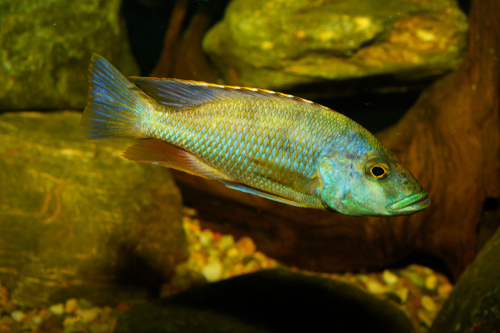
- Scientific Name: Nimbochromis livingstonii
- Full-Grown Size: Approx. 9 inches
- Care Difficulty: Intermediate
- Good Tank Mates: Rafael Catfish, Plecos, African Cichlids
- Place of Origin: East Africa
Livingston’s Cichlids, or Livingstonii Cichlids, are colorful and charismatic – and they can be pretty sociable too. They are known to be moderately aggressive with the other fish in their tank which means that they can hold their own with your Venustus until they decide on whose area will be whose.
They like to have a lot of space that they can swim around in and a natural décor that is similar to their natural habitat in Africa. For fish of this size, Livingstonii Cichlids are considered relatively easy to care for but you do need to be careful if you are housing multiple together as males will aggressively compete with one another.
2. Red Empress Cichlid
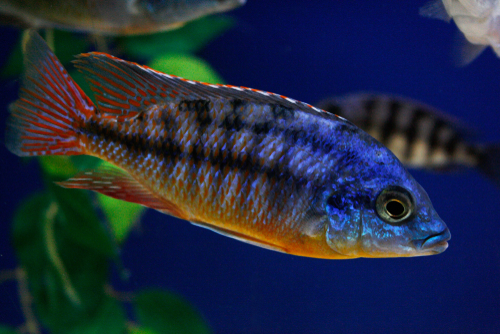
- Scientific Name: Protomelas taeniolatus
- Full-Grown Size: Approx. 6 inches
- Care Difficulty: Easy
- Good Tank Mates: Ropefish, Pictus Catfish, Blood Parrot Cichlid
- Place of Origin: East Africa
Another African Cichlid of a similar size and temperament is the Red Empress, sometimes known as the Spindle Hap. They are also not too tricky to look after so they are a good option for a beginner to the hobby.
They have bright and vibrant coloring that changes across their bodies and each one will have its own unique marking and patterns. They are more relaxed and docile than other cichlids tend to be but they are still active and interesting to watch.
They like to sift through sand so they will rearrange the substrate, and they will want some rocks to hide in too.
3. Sunshine Peacock
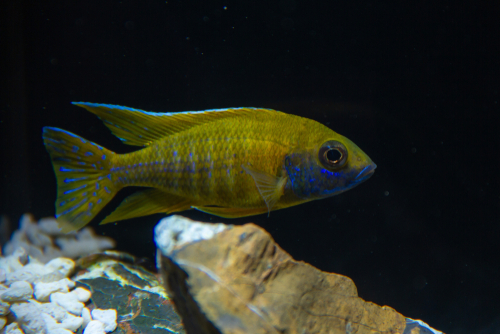
- Scientific Name: Aulonocara Baenschi
- Full-Grown Size: Approx. 7 inches
- Care Difficulty: Moderate
- Good Tank Mates: Clown Plecos, Botia Loches, African Cichlids
- Place of Origin: East Africa
You might be noticing a bit of a pattern here! Another beautiful cichlid that originates from Lake Malawi in Eastern Africa, the Sunshine Peacock also loves the same kind of environment as your Venustus.
Sunshine Peacocks are moderately aggressive and can hold their own against the larger Venustus. They have their own bright and special appearance too. These fish are notable for the blue, yellow, and red shades that have given them their very apt name.
4. Electric Blue Hap
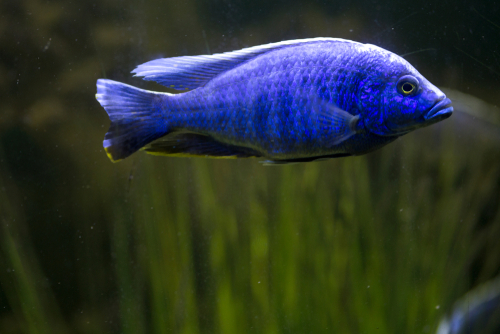
- Scientific Name: Sciaenochromis ahli
- Full-Grown Size: Approx. 8 inches
- Care Difficulty: Easy
- Good Tank Mates: Cuckoo Catfish, Peacock Cichlids, Deep-Water Haps
- Place of Origin: East Africa
One more Lake Malawi native to add to the list, the Electric Blue Haps very much lives up to its title. You won’t find a more vibrant species than this but, even so, they are slightly overlooked in the aquarium community.
They have a semi-aggressive nature so they aren’t going to be pushed around by your Venustus and their needs are pretty straightforward, so they are actually quite a good option for beginners.
They like to explore and they like to hide so you need some pretty stable structures in the tank for them to spend their time in. It is generally a good idea to avoid housing them with other Cichlids that have the same coloring as this can trigger them to become territorial and aggressive.
5. Clown Loach
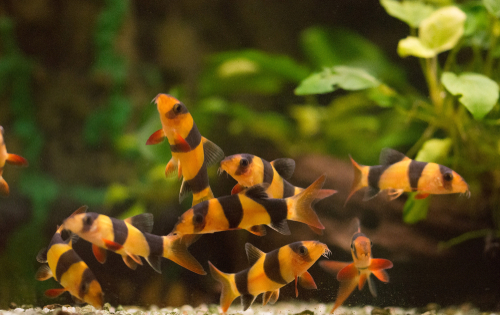
- Scientific Name: Chromobotia macracanthus
- Full-Grown Size: 6 – 10 inches
- Care Difficulty: Easy
- Good Tank Mates: Barbs, Danios, Cory Catfish
- Place of Origin: Indonesia
Moving away from the Cichlid family, Clown Loaches are one of those fish that just seem to get along with everybody. They have great personalities and they are a decent size so they won’t be vulnerable to a Venustus.
Their distinctive black stripes and bright orange/yellow bodies are charming enough on their own, but they are also very playful and sweet-natured. Consider getting more than one clown loach because they prefer to be in groups.
6. Bristlenose Pleco
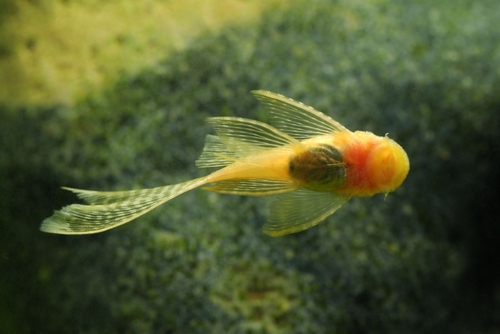
- Scientific Name: Ancistrus cirrhosus
- Full-Grown Size: Approx. 6 inches
- Care Difficulty: Easy
- Good Tank Mates: Kuhli Loach, Guppies, Danios
- Place of Origin: South America
This is another species that is much loved for being a really good tank mate for almost anyone. They spend most of their time relaxing at the bottom of the tank and they don’t like to cause any trouble, but they are also pretty sizable so they aren’t threatened by a slightly aggressive species either.
It should come as no surprise that these fish have bristly noses which, coupled with their patterned bodies, makes them a really intriguing and attractive addition to any aquarium.
7. Featherfin Catfish

- Scientific Name: Synodontis eupterus
- Full-Grown Size: Approx. 8 inches
- Care Difficulty: Moderate
- Good Tank Mates: Gouramis, Clown Loach, Elephant Nose
- Place of Origin: Africa
Many of the larger and more confident Synodontis catfish species can be a good fit for a Venustus Cichlid, and they are well-loved for their quirky behavior, their hardy nature, and their ability to get along with others.
The Featherfin Squeaker catfish is large enough that it won’t look like food and confident enough that it won’t be bossed around either. They also have wonderful spots all over their bodies and an incredible dorsal fin from which they earned their name.
As with other Upside Down Catfish, you will often find them resting with their tummies in the air, but they also love to explore and find places to hide.
8. Cuckoo Catfish
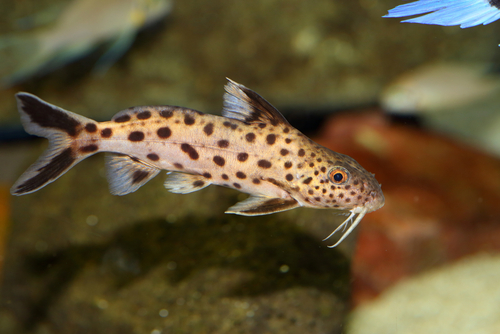
- Scientific Name: Synodontis multipunctatus
- Full-Grown Size: Up to 10 inches
- Care Difficulty: Moderate
- Good Tank Mates: African Cichlids, Gouramis, Loaches
- Place of Origin: Africa
Another excellent Synodontis catfish option is the Cuckoo, which tends to be a good fit for most of the less-aggressive African Cichlids. In fact, Cuckoo Catfish have earned their name due to the slightly symbiotic relationship that they have developed with Cichlids by tricking Cichlid mothers to raise their young for them!
These fish can be very territorial with other species, apart from Cichlids. They are happiest with around 2 or 3 Cichlid friends to live alongside, especially if you want to breed them.
Summary: Top Tank Mates For Venustus Cichlids
So, who makes the best tank mates for a Venustus Cichlid? Well, the most compatible species are generally other African Cichlids of a similar size and a similar temperament. You don’t want to be housing them with much smaller and much more docile fish but you equally don’t want a fish that is very aggressive and domineering.
There are a few other excellent options that you could choose from, though, including some of the Synodontis Catfish species like the Cuckoo and the Featherfin, or the ever-friendly and always popular Bristlenose Pleco and Clown Loach.

Veteran fish keeper and keen hobbyist with a serious case of MTS. My midlife crisis was the establishment of a fish room, much to my wife’s horror. Little does she know it could be worse!!


